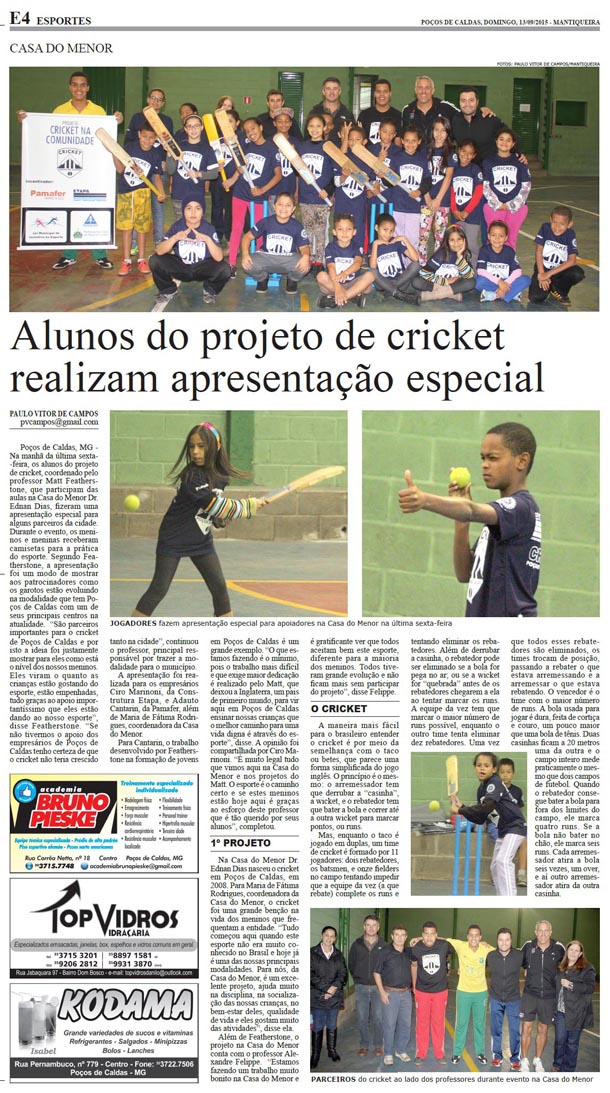Students of the Cricket project Poços de Caldas make a special presentation
Written by Paulo Vítor Campos
Poços de Caldas, MG – Last Friday morning, the students of the cricket project, coordinated by Professor Matt Featherstone, who participate in classes at Casa do Menor Dr. Ednan Dias, made a special presentation for some partners in the city. During the event, the boys and girls received t-shirts to practice the sport. According to Featherstone, the presentation was a way of showing sponsors how the boys are evolving in the modality that has Poços de Caldas with one of its main centers today. “They are important partners for the Poços de Caldas cricket and for this reason the idea was precisely to show them how our boys are doing. They saw how much the children are enjoying the sport, they are committed, all thanks to the very important support that they are giving to our sport ”, said Featherstone. “If we do not have the support of the businessmen of Poços de Caldas I am sure that cricket would not have grown so much in the city”, continued the professor, the main responsible for bringing the sport to the municipality.
The presentation was given to entrepreneurs Ciro Marinoni, from Construtura Passo, and Adauto Cantarin, from Pamafer, in addition to Maria de Fátima Rodrigues, coordinator of Casa do Menor.
For Cantarin, the work developed by Featherstone in training young people in Poços de Caldas is a great example. “What we are doing is the minimum, as the most difficult and demanding work is done by Matt, who left England, a first world parent, to come here in Poços de Caldas to teach our children the best way to a dignified life is through sport, ”he said. The opinion was shared by Ciro Marinoni. “Everything we saw here at Casa do Menor and Matt’s projects is really cool. Sport is the right way and if these boys are here today it is thanks to the effort of this teacher who is so dear to his students ”, he added.
First project
At Casa do Menor Dr. Ednan Dias was born cricket in Poços de Caldas, in 2008. For Maria de Fátima Rodrigues, coordinator of Casa do Menor, cricket was a great blessing in the lives of the boys who attend the organization. “It all started here when this sport was not well known in Brazil and today it is already one of our main modalities. For us at Casa do Menor, it is an excellent project, it helps a lot in the discipline, in the socialization of our children, in their well-being, quality of life and they are very fond of activities ”, she said.
In addition to Featherstone, the project at Casa do Menor has professor Alexandre Felippe. “We are doing a very beautiful job at Casa do Menor and it is gratifying to see that everyone accepts this sport well, different for most boys. Everyone has had great progress and is no longer without participating in the project ”, said Felippe.
Cricket
The easiest way for the Brazilian to understand cricket is through the resemblance to the bat or betes, which looks like a simplified form of the English game. The principle is the same: the pitcher has to knock down the “little house”, the wicket, and the hitter has to hit the ball and run to the other wicket to score points, or runs.
But, while the bat is played in pairs, a cricket team is made up of 11 players: two batters, the batsmen, and eleven fielders on the field trying to prevent the team of the time (the one batting) from completing the runs and trying to eliminate the hitters. In addition to knocking down the box, the hitter can be eliminated if the ball is caught in the air; or if the wicket is “broken” before the batters reach it when trying to score the runs. The next team has to score as many runs as possible, while the other team tries to eliminate ten hitters. Once all these hitters are eliminated, the teams change positions, starting to hit what they were shooting and to throw what they were hitting. The winner is the team with the most runs. The ball used to play is hard, made of cork and leather, slightly larger than a tennis ball. Two little houses are 20 meters from each other and the entire field measures practically the same as two football fields. When the hitter manages to hit the ball out of bounds, he scores four runs. If the ball does not hit the ground, he scores six runs. Each pitcher throws the ball six times, one over, and then another pitcher shoots from the other box.

Jornal Mantiqueira – Poços de Caldas – Sunday edition 09/13.15

